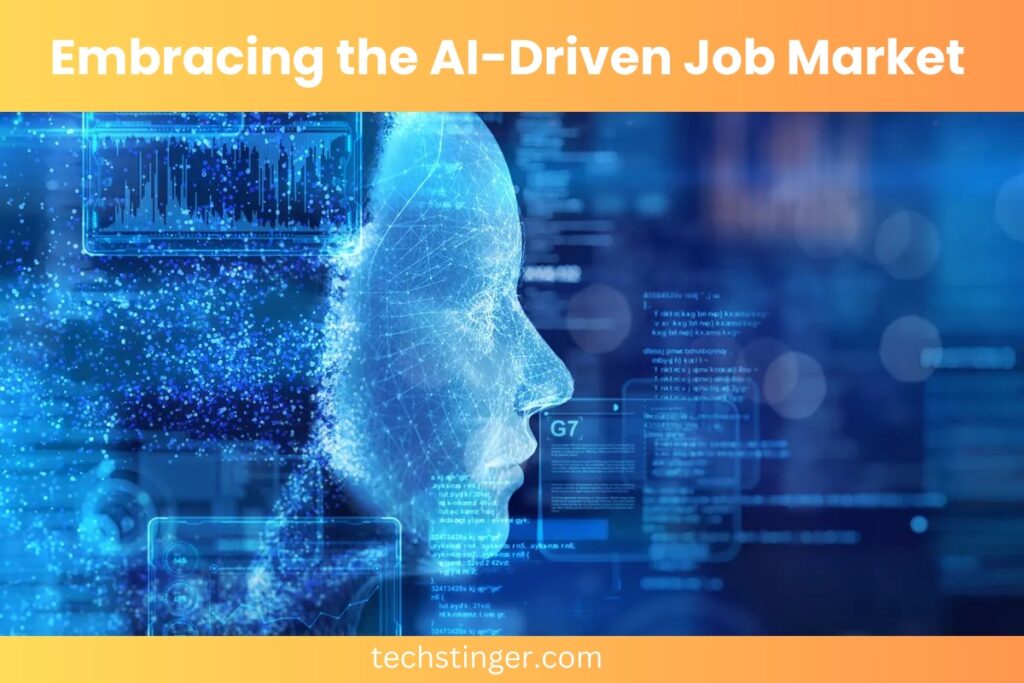Navigating the Future: Embracing the AI-Driven Job Market

The effects of artificial intelligence (AI) on the labour market cannot be overlooked in the quickly changing world of today. Industries are going through enormous changes as a result of the exceptional rate at which AI technologies are developing. This essay examines the significant changes brought about by the AI-driven employment market and provides advice on how people and organisations can adapt to and prosper in this new environment.
Smartphones and self-driving cars are only two examples of how artificial intelligence has transformed many facets of our life. The job market is one area where its effects are very noticeable. A change in the nature of labour has resulted from the rise of automation, machine learning, and predictive analytics, posing both opportunities and difficulties for both people and enterprises.
Understanding AI’s Role in the Job Market
Defining Artificial Intelligence
AI is mostly used to describe devices or systems that can mimic the functions of human intelligence. Problem-solving, learning, making decisions, and even language processing are included in this. The ability of AI to analyse big datasets and provide actionable insights has made it an indispensable tool for a variety of sectors.
AI’s Influence on Job Roles
Traditional employment responsibilities have been altered by AI integration, and new ones have also been established. Previously manual routine chores are now automated, freeing up workers to concentrate on higher-level cognitive processes. However, worries about losing jobs have also surfaced, necessitating the need for people to adapt and pick up new skills.
Embracing Change: Adapting to AI-Driven Trends
Upskilling and Reskilling for the Future
Upskilling and reskilling are essential career longevity techniques since some work roles become obsolete. Continuous learning not only improves employability but also gives people the skills they need to adopt new technologies.
Hybrid Work Environments
The epidemic hastened the adoption of remote work, and AI has been instrumental in making this transformation possible. Employees will need to use AI tools for seamless collaboration as hybrid work models, which combine remote and in-person work, are set to become the norm.
Industries Reshaped by AI
Manufacturing and Automation
Automation powered by AI has significantly increased efficiency and precision in the industrial sector. This has improved total output, streamlined production procedures, and decreased errors.
Healthcare and Medical Advancements
Diagnostics, medication research, and patient care have all been transformed by AI. AI’s contributions have facilitated more precise diagnosis and individualised treatment regimens through fields like robotic surgery and predictive analytics.
Finance and Data Analytics
AI algorithms are used in the financial sector to make instantaneous investment decisions and spot fraudulent activity. This has changed how financial institutions work and how they interact with their clients.
The Human Touch: Irreplaceable Skills in the AI Era
Creativity and Innovation
While AI is excellent at processing data, it lacks human creativity and innovation. These abilities are still in great demand since they are essential to the creation of new goods, services, and solutions.
Emotional Intelligence and Empathy
Emotional intelligence and empathy are crucial skills in occupations requiring human connection, such as counselling and customer service. While AI may increase productivity, these particular traits are essential to real human connections.
Preparing the Workforce of Tomorrow
Education’s Role in AI Adaptation
Institutions of higher learning must modify their courses to give pupils AI-related skills. This requires adaptation, critical thinking, and ethical reasoning in addition to technical expertise.
Collaboration Between Humans and AI
AI is most successfully used in areas where people and machines work together. Human monitoring ensures moral decision-making and avoids the biases prevalent in AI systems from being maintained.
Ethical Considerations and AI
Addressing Bias in AI Algorithms
Inadvertently reinforcing biases found in their training data is a risk of using AI systems. It’s essential to recognise and address these prejudices in order to promote fairness and equity and prevent systemic disparities from being reinforced.
Ensuring Transparency and Accountability
To foster trust, AI decision-making must be transparent. People need to understand how AI makes decisions, especially in industries with high stakes like healthcare and finance.
Challenges and Opportunities in the AI-Driven Job Market
Job Displacement and Transition
There is a chance that some job roles will be eliminated as a result of the broad use of AI. History has demonstrated, however, that technical developments can open up new opportunities, necessitating personal adaptation and the development of new abilities.
New Avenues for Employment
The emergence of AI creates new job opportunities, including those for data analysts, AI trainers, and AI ethics experts. People can take advantage of these chances as long as they stay aware of new trends.
Navigating Career Paths in the AI Era
Identifying Marketable Skills
In the age of AI, skills like data analysis, programming, and AI system administration are in high demand. To maintain their competitiveness in the employment market, people should invest in learning these skills.
Exploring Emerging Job Roles
The variety of opportunities presented by AI is highlighted by newly emerging positions like AI trainers (educators who instruct AI systems) and AI explainability specialists (professionals who guarantee AI judgements are intelligible).
Conclusion
The AI-driven job market offers a scene of change and opportunity. While it presents difficulties, it also presents hitherto unheard of chances for innovation and expansion. Individuals and businesses may confidently navigate this changing environment by embracing change, upskilling, and developing uniquely human talents.

